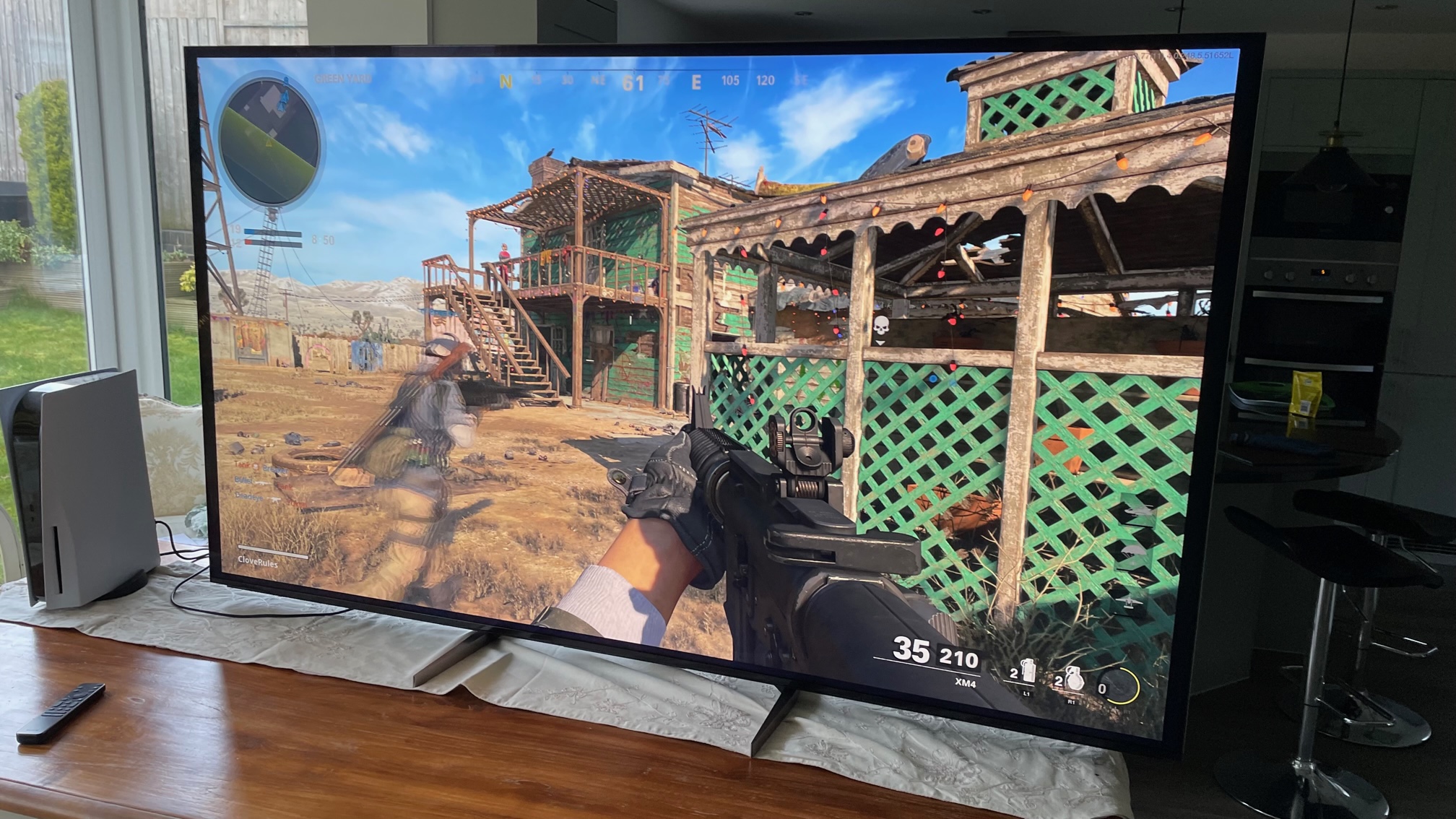GamesRadar+ Verdict
Sony’s king-sized Mini LED debutante is a brilliant addition to Sony’s uniquely varied TV line up, combining generally excellent and impressively bright pictures with a potent built-in sound system that makes adding a soundbar or external speaker system more of a luxury than a necessity.
Pros
- +
Bright, colourful, surprisingly contrast-rich pictures
- +
Supports 4K/120Hz and VRR gaming
- +
Powerful Dolby Atmos audio playback
Cons
- -
Backlight blooming during off-axis viewing
- -
Slight softness when showing motion
- -
Only two 4K/120Hz HDMIs, and fewer gaming features than some rivals
Why you can trust GamesRadar+
The TV world has never offered as many different screen types as it does right now. There’s OLED, Quantum Dot OLED, edge LED, direct LED, Mini LED… and Sony, uniquely, supports them all.
Given how great a time we had recently with Sony’s sublime QD OLED debutante, the 65A95K, we thought we’d waste no time in getting our hands on another Sony newbie in the huge shape of the 75-inch 75X95K - the brand’s first Mini LED TV.
If you haven’t heard of Mini LED before, it’s basically a new way of illuminating LCD TVs that uses far smaller LED lights. The idea being that making the LEDs smaller allows you to fit many more of them into a screen, delivering potentially far more brightness and light control. Sony already had a reputation for delivering some of the brightest and most colourful LCD TVs around even before it embraced Mini LED technology, so if the 75X95K can substantially improve on those traditional LED predecessors it could be pretty irresistible. Especially given its cinematic screen size and the brand's prowess among the best gaming TVs on the market.
| Sizes | 75-inch / 85-inch |
| Display Type | Mini LED |
| Refresh Rate | 120Hz |
| HDR | Dolby Vision, HDR10, HLG |
| VRR | Yes |
| HDMI 2.1 | Yes |
| Input Lag | 19.7ms (1080/60) |
Design
The 75X95K is an absolute beast aesthetically - and we don’t mean that in an entirely complimentary way. Despite using much smaller LEDs than usual, its sides run much deeper - around an inch - than we’re used to seeing these days. And then much of the rest of the rear sticks out another inch further. The set is seriously heavy and awkward to lift as well, it's a million miles away from the increasingly light builds of the latest premium QD OLED and OLED TVs.

Sony has achieved a sort of monolithic appeal, though, by making its rear panel almost as flat as its screen. Plus that rear panel has been glammed up by a grid pattern embossed into its plastic and a series of clip on panels that can cover all of its ugly connection points. Its chunky sides are finished in an appealing metallic silver too, and it sits on a pair of narrow but sturdy silver metal feet that helpfully become so narrow when viewing the TV head on that you barely see them.
The feet can be positioned either under each corner of the screen or more centrally, depending on the width of the furniture you’re sitting the TV on. If you’re thinking of wall hanging it, please bear in mind that the wall will need to be pretty sturdy.
The TV ships with two remote controls: a standard, button-heavy basic model, and a much more premium model with a reduced button count and a lovely heavyweight metallic finish. The ‘posh’ remote is also backlit, with the lighting behind the buttons being activated simply by picking the remote up.
Features
As usual with Sony’s current generation of TVs, the 75X95K’s connectivity is a mixed bag. On the upside, the TV can handle 4K feeds at 120Hz refresh rates, as well as variable refresh rates and three flavours of HDR: HDR10, HLG and Dolby Vision. It can’t, though, deliver 4K at 120Hz and Dolby Vision simultaneously, like one or two rival TVs can. You have to choose between the two. Also, only two of the provided four HDMIs support sufficient bandwidth to handle 4K/120Hz feeds.
Sony’s VRR support is limited, meanwhile, to the HDMI org’s implementation of the technology. There’s no support for AMD’s Freesync or NVidia G-Sync options. This doesn’t mean you shouldn’t still experience a good VRR experience, though. You should also find the 75X95K switching automatically into its Game setting when it detects a PC or console is playing a game rather than video source.
In fact, if you're on the hunt for the best TV for PS5, you can take advantage of Sony’s ‘Perfect for PS5’ system. This means the console can identify the exact model of TV it’s connected to and optimise its high dynamic range gaming image output accordingly, without you needing to do anything yourself.
The Mini LED lighting engine that illuminates the 75X95K’s pictures is backed up by a local dimming system capable of simultaneously delivering different light levels from a very impressive 600 independent backlight zones. There are actually one or two TVs out there that boast more dimming zones than this, but experience shows that it’s not always the sheer number that counts; it’s how you use them.
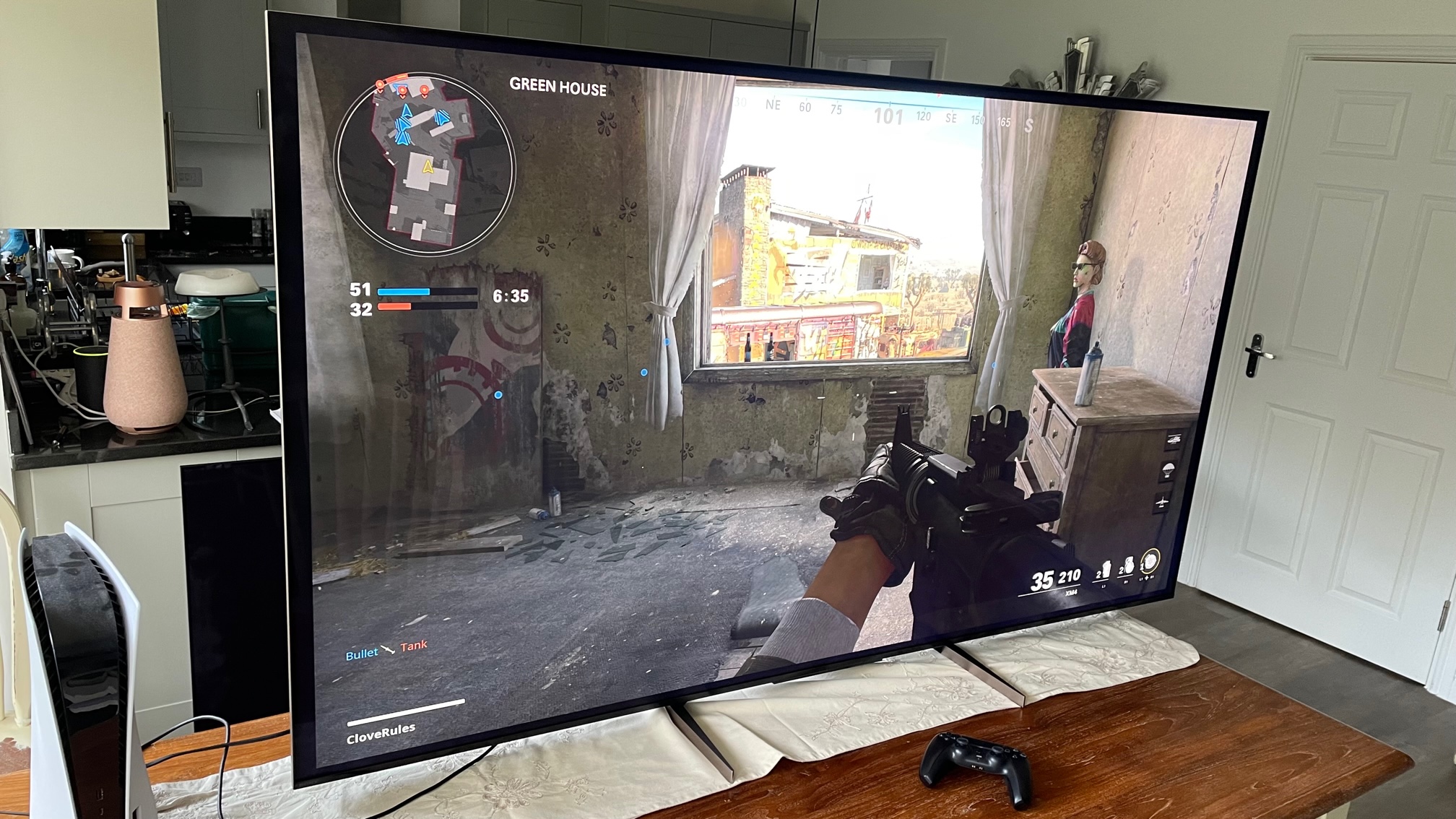
This brings us to Sony’s Cognitive XR processor, which has been especially tweaked to get the most from the specific strengths of the 75X95K’s large Mini LED panel. The Cognitive XR system works on many picture elements, including upscaling of HD to 4K, conversion of standard dynamic range to HDR with some picture presets, motion judder and blur management, noise reduction and an over-arching attempt to make every incoming image appear more in keeping with the way your eyes view the real world. If you add an optional Bravia Cam camera attachment to the 75X95K, you can even get the TV to provide picture and sound that’s optimised to your room layout and seating position. The 75X95K has also been accredited as ‘IMAX Enhanced’ capable, meaning its pictures are deemed good enough to do justice to IMAX’s premium home video mastering system (IMAX Enhanced titles can be found on Disney+, Bravia Core or a few 4K Blu-ray discs).
The 75X95K’s smart features are, as always with Sony TVs these days, delivered by the Google TV platform, backed up by YouView to fill in Google TV’s gaps when it comes to one or two of the UK’s terrestrial broadcaster services. This combination really does cover pretty much all the bases, as well as providing Sony's Bravia Core service. This lets you access movies and TV shows at unusually high bit-rates of up to 80Mbps, so that people with fast broadband connections can enjoy a premium AV experience. Buying the 75X95K entitles you to five free movies on the Bravia Core platform, and 12 months of free TV show streaming.
The last big feature attraction of the Sony 75X95K is its Acoustic Multi-Audio sound system. This uses a multi-speaker array including two subwoofers for bass and so-called ‘sound-positioning tweeters’ to create a large soundstage that manages to position sound effects so that they precisely match the onscreen action.
Overall the Sony 75X95K’s combination of a mammoth screen and promisingly premium picture and sound technologies makes its £2,499 price look potentially very reasonable. Provided, of course, that its performance lives up to all the fancy spec.
Display Performance
The Sony 75X95K’s pictures vary between excellent and good - which seems more than fair enough for such a well-featured 75-inch TV you can get for £2,499.
Contrast is strong for such a big LED-lit screen. During fade to blacks, in fact, the 75X95K’s screen can achieve pretty much OLED-like black levels without seemingly having to fully turn off the backlight in the sort of distracting way pretty much any rival LCD TV would have to. Even more impressively/usefully, Sony’s management of the 75X95K’s local dimming engine allows the black bars you get above and below wide aspect ratio pictures to retain their impressively inky blackness at pretty much all times, without being distractingly infiltrated by light blooms cast off from bright objects within the main picture.
These local dimming-inspired black levels are good enough to deliver dark and mid-dark scenes, as well as dark parts in otherwise bright shots, with more authority and authenticity than the vast majority of other LCD TVs. They generate precious little overt backlight blooming around stand out bright objects (though some is noticeable if viewing from an angle), and remarkably do so without having to dim those small bright objects down heavily (the latter being an issue that Samsung’s otherwise brilliant Mini LED TVs can suffer with).
The 75X95K’s ability to deliver good black levels while also being sparklingly bright (we measured a maximum of 1711 nits on a white 10% HDR window) helps it bring out excellent amounts of shadow detail in even the darkest corners of the screen, too. There’s no evidence of faint, dark picture information being crushed out of the picture. This shadow detailing helps dark scenes feel consistent with bright scenes when it comes to their sense of depth and solidity.
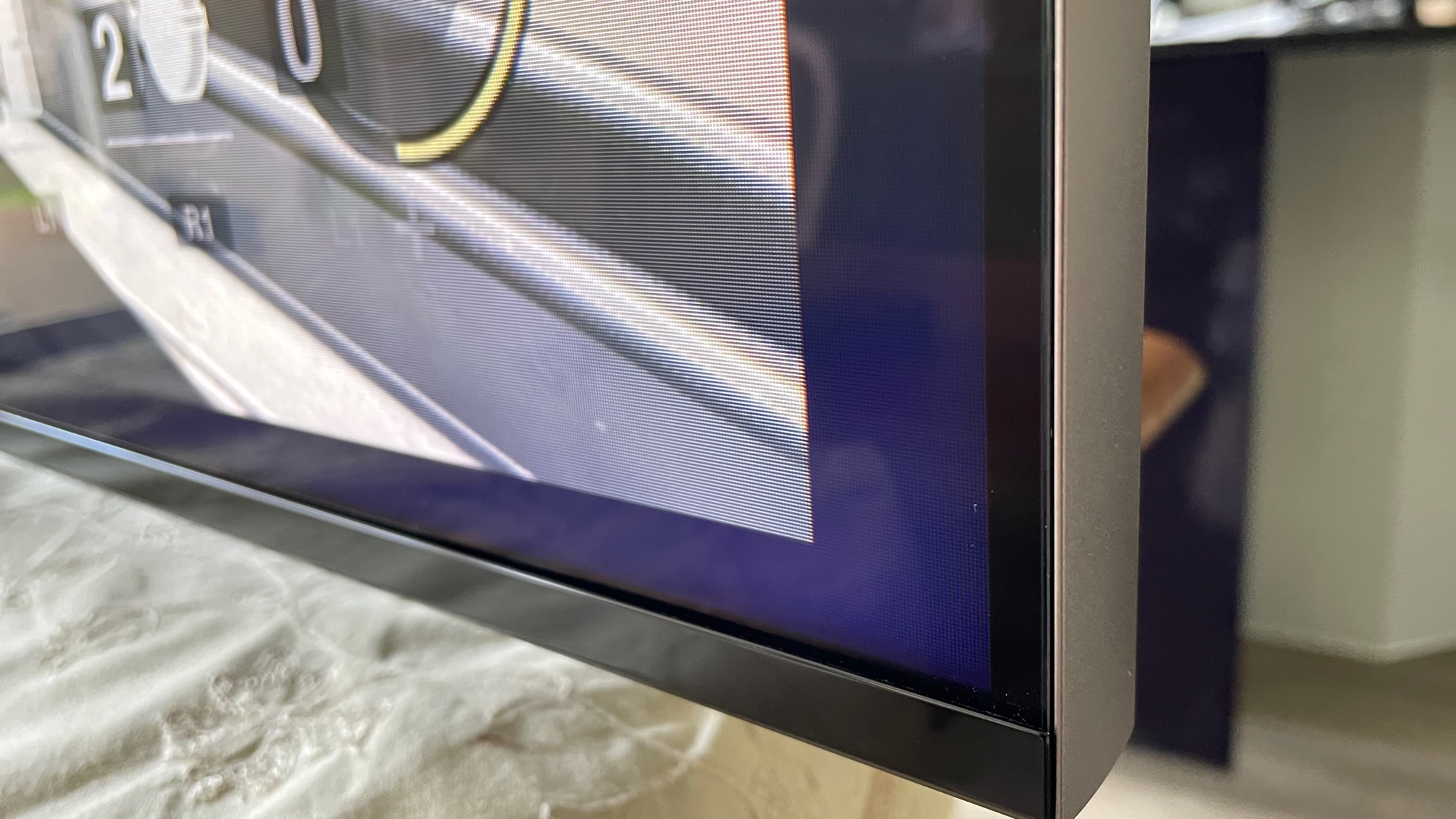
The 75X95K’s potent brightness delivers an unusually strong sense of high dynamic range content’s expanded light range, as well as helping pictures hold up well in bright rooms. Though having said that, thanks to the contrast it manages to deliver with this brightness, this is a set that definitely rewards proper curtains-drawn, lights-off movie nights. Something many of the prospective buyers of such a huge TV will want to enjoy as often as possible.
While the brightness is impressive, it’s not excessive. The brightest highlights of HDR pictures don’t suffer excessively with clipping (loss of subtle shading and colour information), and even the very brightest areas of colour don’t look washed out thanks to the wide colour gamut the screen can produce.
As usual, Sony’s video processing ensures that there’s almost infinite subtlety in the way colour blends and tonal shifts are reproduced, helping pictures - especially skin tones - look strikingly immersive and natural in both the boldly enjoyable Standard preset and the more muted but more accurate Cinema preset.
Native 4K images look suitably detailed, showing off the benefits all those pixels can have on a screen this big, while Sony’s impressive processing does a lovely job of upscaling HD and even SD content to take advantage of the screen’s 4Kness without looking forced, soft or noisy.
The 75X95K’s usually excellent pictures occasionally drop to being merely good. The very darkest scenes, for instance, such as the one in the cellar near the start of ‘It’ on 4K Blu-ray, can take on a rather green undertone that sometimes brings out actually slightly more background detail than you’re really supposed to see.
This sounds pretty bad on paper, but strangely, while more neutral black tones would be preferable, the green undertone effect doesn’t feel the same/as bad as the low-contrast greyness you often see to varying degrees with LCD TVs. You still feel as if you’re seeing actual picture content, rather than as if you’re seeing a typical low-contrast grey fog hanging over the picture.
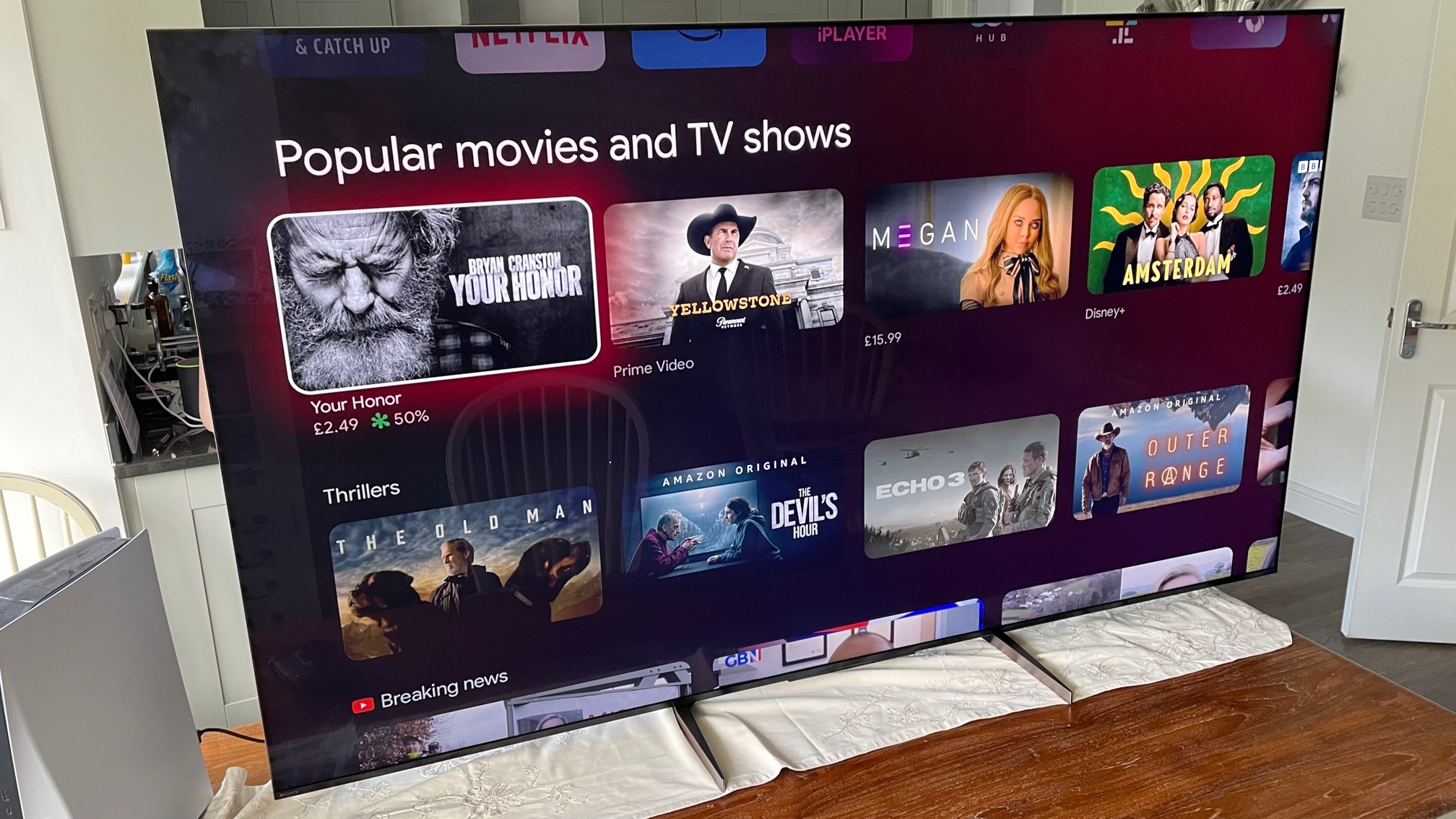
The 75X95K’s black levels are actually at their most neutral in the TV’s Vivid picture preset. But this tends to overcook some other picture elements, leaving the Standard option as your best default preset.
The Standard preset also occasionally generates, though, some gently distracting brightness fluctuations during very dark sequences - though such moments really are rare and don’t occur at all in the Cinema preset. The Cinema preset can exhibit a touch more traditional greyness over very dark scenes - though not enough to stop pictures from still being impressively contrast rich for a large LCD TV. The Cinema preset also looks generally flatter and milder than the Standard preset, but this is only to be expected.
The 75X95K’s images look a touch flatter with mid-dark shots than they do the rest of the time, too. Seemingly because even a mini LED lighting system with 600 dimming zones can’t quite find a way of delivering such content without more contrast and backlight clouding compromises than you get with more extreme content.
While Sony is typically one of the best handlers of motion in the TV world, motion-packed images actually feel a touch soft on the 75X95K. There’s a touch of blurring and resolution loss - even if you’re gaming in 4K/120Hz - that we weren’t completely able to resolve without setting Sony’s Motionflow processing to such a high level that it started to introduce the over-smooth soap opera effect.
Having mentioned the 75X95K’s gaming experience, we also missed being able to game in Dolby Vision at 120Hz rates, and couldn’t help but be struck by how few gaming specific features and signal information the 75X95K carries compared with LG and Samsung’s premium TVs. To be fair, the 75X95K’s brightness, contrast, colour finesse, epic dimensions and 19.7ms of input lag still make it a seriously fun gaming experience. But it’s not state of the art.
Audio Performance
The 75X95K’s always enjoyable, sometimes outstanding pictures are joined by impressively potent audio. Pushing it hard with a series of favourite Dolby Atmos scenes (which the TV can decode) reveals, for starters, excellent staging. Dialogue is not just locked to the screen but locked to the right part of the screen for each talker, for instance, and the rest of the soundstage spreads impressively far to left and right, as well as creating a reasonable sense of verticality for Dolby Atmos’s height effects.
There’s enough power behind the 75X95K’s sound projection, too, to ensure that it always sounds coherent and doesn’t become sound thin, congested or strained even during the most full-on action scenes. The speakers are sensitive enough to reveal every detail a mix might contain as well, and because it has more speakers than most TVs at its disposal, it’s able to place those details with enough location accuracy, relative weight and clarity to make the soundstage seem busy and convincing.
Trebles are well rounded, avoiding harshness, while at the other end of the audio spectrum there’s enough bass to give action scenes a strong sense of scale without the low frequency drivers falling prey to phutting, buzzing or crackling interference.
In a perfect world the sound would have a bit more forward projection to go with the sideways and upwards delivery. Even as it stands, though, the 75X95K’s sound system does a better job than the vast majority of TVs of actually making Dolby Atmos sound as if you’re listening to a multi-channel, object-based audio format.
Should you buy the Sony XR-75X95K?
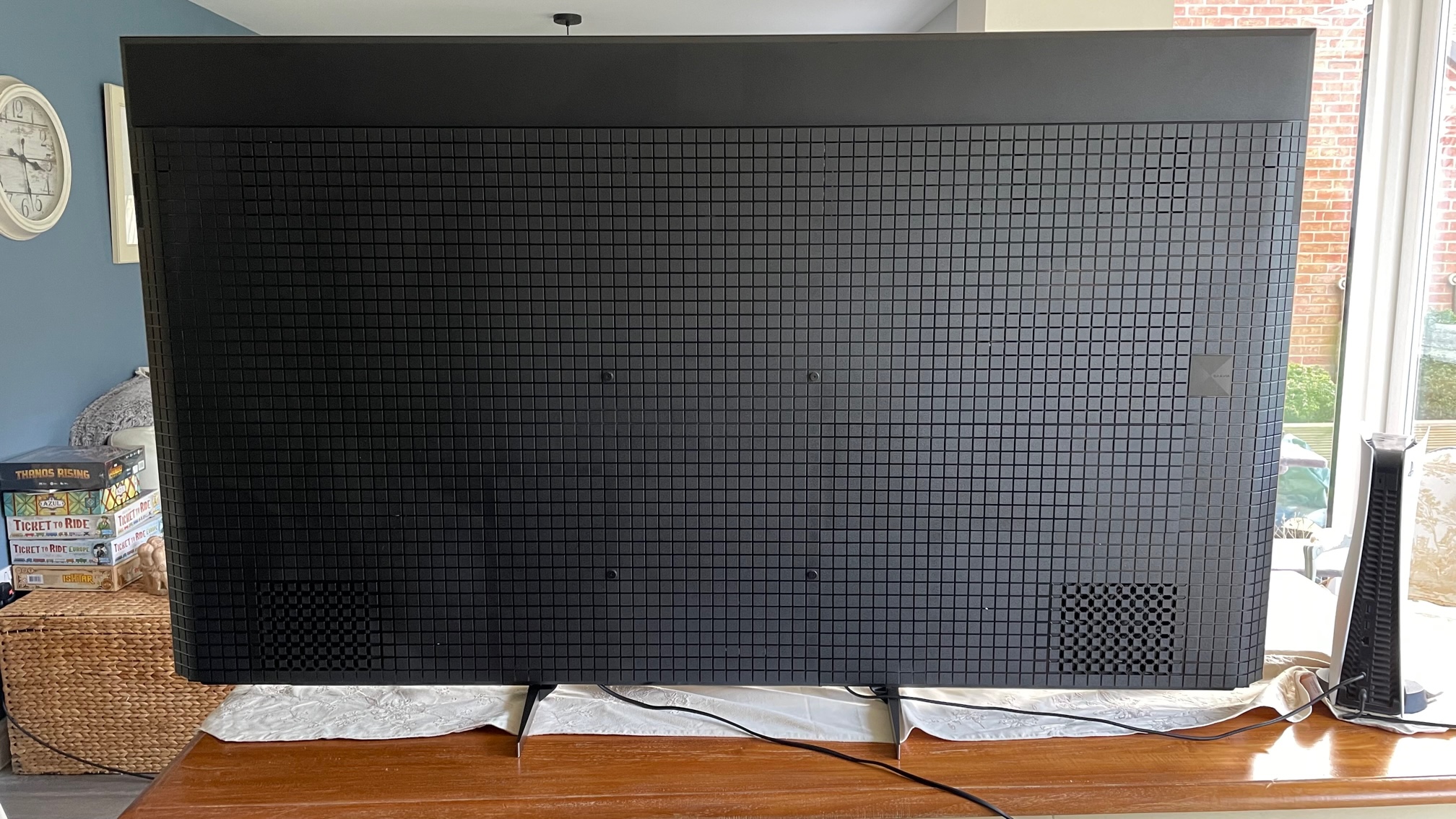
It’s hard to believe the 75X95K is Sony’s first Mini LED TV. The brand has brought its decades of cutting edge picture processing know-how and excellent backlight management to the 75X95K’s party, resulting in a frequently dazzling combination of high brightness, rich colours and levels of black level and contrast seldom seen with LCD TVs.
It’s not as rich in game features as some rivals (though it gets the job done well enough for most gamers), and its usually stellar pictures occasionally lose a little sharpness and dynamism. By the time you’ve added its powerful and expressive audio to the mix, though, the 75X95K stands as an excellent big-screen option for its money.
How we tested the Sony XR-75X95K
With any premium LCD TV the first things to be on the look out for are how bright it is and how well it combines that brightness with contrast and backlight control. This meant feeding the 75X95K lots of contrast-rich high dynamic range content from a range of familiar 4K Blu-ray discs and boldly mastered HDR streamed content, such as Netflix’s Wednesday show.
Various scenes from Blade Runner 2049 and the projector in the garage sequence from It on 4K Blu-ray were used to push the 75X95K’s audio to the edge, while its gaming chops were mostly explored using Call Of Duty Modern Warfare 2 and Assassin’s Creed: Valhalla running from the Xbox Series X and PS5 using a variety of their different graphical options. For more information on how we test TVs, be sure to check out the full GamesRadar+ Hardware Policy.
We're also rounding up all the best 120Hz 4K TVs on the market right now, but if you're after a saving be sure to check out the latest cheap TV deals on the shelves. Or, for something a little smaller, take a look at the best gaming monitors we've found.
John has spent more than a quarter of a century writing about and reviewing pretty much every type of home entertainment product, from games consoles and soundbars to projectors, 4K Blu-ray players, streaming boxes, and, especially, TVs. As well as on GamesRadar+, his words of wisdom can be found as far afield as, T3, Tech Radar, Home Cinema Choice, Expert Reviews, and Forbes, while most of his spare time is spent wondering ruefully how much more sleep he might have had and how much higher his gamerscore might have been if only he hadn’t spent the past 15 years hopelessly and largely unsuccessfully addicted to Call Of Duty.
